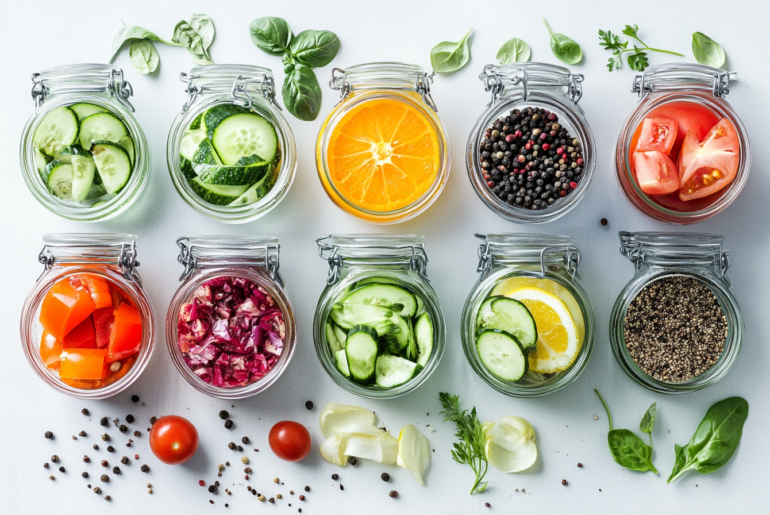This article may contain references to products or services from one or more of our advertisers or partners. We may receive compensation when you click on links to those products or services. Nonetheless, our opinions are our own.
- Key Highlights
- Understanding Common Food Costs and Their Alternatives
- Exploring Flavorful Vegetable Substitutes in Your Favorite Dishes
- Smart Swaps for Dairy Products That Won’t Sacrifice Taste
- Affordable Protein Alternatives to Keep Your Meals Nutritious
- How to Replace Expensive Grains with Budget-Friendly Options
- Tips for Finding Seasonal Produce to Maximize Savings
- Cooking Techniques That Maximize Flavor
- A Complete Guide to Making Homemade Chicken Stock
-
Frequently Asked Questions
- What are practical food substitutions for dairy products?
- How can I substitute meat in my meals?
- What can I use instead of eggs in baking?
- Are there substitutes for butter in recipes?
- How can I replace refined sugar in my dishes?
- What are some good substitutes for rice and pasta?
- Can I substitute flour in my baking recipes?
- What should I consider when making food substitutions?
- Recommended Reads
Key Highlights
In today’s fast-paced world, it’s no surprise that we sometimes scramble to create meals with whatever ingredients we have. Whether you’re trying to stick to a budget, utilize what’s left in your pantry, or accommodate dietary restrictions, knowing how to substitute ingredients effectively can be a game-changer in the kitchen. You’ll discover eight practical food substitution tips that help you save money and inspire creativity in your cooking. By the end, you’ll feel empowered to whip up delicious meals without the stress of running to the store. Let’s dive into these simple yet effective strategies that will transform how you approach meal planning!
Understanding Common Food Costs and Their Alternatives
Understanding the costs associated with common foods can significantly affect your budget for grocery shopping. You might reach for name-brand products that don’t consistently deliver more value. Instead, consider opting for generic or store-brand items. These often have the same ingredients and quality as their pricier counterparts but come at a fraction of the cost. Here are some additional substitutes that can help your wallet:
- Organic Produce vs. Conventional Produce: Unless they are on sale, choose conventional fruits and vegetables instead of organic varieties.
- Fresh Herbs vs. Dried Herbs: Substitute dried herbs with fresh ones, using about a third of the amount called for in recipes.
- Whole Chicken vs. Chicken Parts: Purchase and cut an entire chicken into pieces, saving more per pound.
- Nut Butters vs. Sunflower Seed Butter: If nut prices are high, switch to sunflower seed butter for a budget-friendly alternative.
Sometimes, swapping ingredients can mean sacrificing a little in flavor, but the savings are often worth it. Here’s a simple comparison table showing a few standard food costs and how you can make budget-friendly choices:
| Item | Average Cost | Alternative | Alternative Cost |
|---|---|---|---|
| Almond Milk | $3.50 | Cow’s Milk | $2.00 |
| Quinoa | $4.00 | Rice | $1.50 |
| Granola Bars | $5.00 | Homemade Oatmeal | $1.00 |
Each of these substitutions can add up to significant savings over time, allowing you more budget flexibility without sacrificing nutrition or taste. Being mindful of these options will bring you closer to healthier financial habits.
Exploring Flavorful Vegetable Substitutes in Your Favorite Dishes
For revamping your favorite dishes, integrating flavorful vegetable substitutes can elevate your meals while keeping your grocery budget in check. For instance, replace traditional grains with cauliflower rice or zucchini noodles to create lighter versions of pasta or rice dishes without compromising taste. These substitutions can reduce carb intake while introducing new textures and flavors that might surprise you.
Consider experimenting with these options to add variety and nutrition:
- Sweet Potatoes instead of White Potatoes: They bring a natural sweetness and added vitamins.
- Eggplant as a Meat Substitute: Its hearty texture makes it an excellent choice in lasagna or stir-fries.
- Chickpeas for Ground Meat: Mashed chickpeas can provide a protein-packed base for tacos or burgers.
- Spinach in Place of Lettuce: A nutrient-dense alternative that works well in salads and sandwiches.
| Original Ingredient | Substitute | Benefit |
|---|---|---|
| White Rice | Quinoa | Higher protein content |
| Ground Beef | Lentils | Lower in fat, higher in fiber |
| Butter | Avocado | Healthy fats and creaminess |
By leveraging these creative swaps, you can discover new flavors, boost your nutrient intake, and save money—a win-win for your culinary adventures and wallet!
Smart Swaps for Dairy Products That Won’t Sacrifice Taste
Making simple swaps in dairy products can lead to health benefits and savings without compromising flavor. Here are some options that you might find enjoyable:
- Greek Yogurt for Sour Cream: If you enjoy a creamy topping on your tacos or baked potatoes, try replacing sour cream with Greek yogurt. It adds a similar tangy flavor while providing more protein and fewer calories.
- Almond Milk is a great substitute for Cow’s Milk. It is perfect in smoothies or cereal. With a subtle nutty flavor, almond milk can save calories and offer a lactose-free option for those with dairy sensitivities.
- Cashew Cream for Heavy Cream: Blend soaked cashews with water to create a rich, creamy texture that works well in sauces and soups. It has fewer calories than traditional cream!
- Ricotta or Cottage Cheese for Cream Cheese: Instead of slathering bagels with cream cheese, try spreading ricotta or cottage cheese, which tastes great and is lower in fat and calories.
These swaps not only keep your recipes delicious but can also ease your budget pinch. Making these minor adjustments in your diet can lead to positive changes in your overall nutrition. Plus, experimenting with different flavors and textures is a fun culinary adventure!
Affordable Protein Alternatives to Keep Your Meals Nutritious
Finding budget-friendly protein alternatives can transform your meals while keeping nutrition and costs low. Consider incorporating lentils into your weekly rotation; they are a fantastic source of protein and incredibly versatile. Use them in soups, stews, or even as a base for veggie burgers. Chickpeas are another solid choice—toss them into salads or blend them into hummus for a delightful snack that packs a punch in the protein department.
Regarding dairy, switch to Greek yogurt for a thicker, creamier option that offers more protein than regular yogurt. It works wonderfully in smoothies and dressings or as a topping for your favorite dishes. Don’t overlook tofu or tempeh either! These soy products are rich in protein and can absorb flavors beautifully, making them perfect for stir-fries or grilled dishes. Below is a simple comparison table showcasing these alternatives:
| Protein Source | Protein per 100g | Cost per Serving |
|---|---|---|
| Lentils | 9g | ~$0.20 |
| Chickpeas | 8.9g | ~$0.25 |
| Greek Yogurt | 10g | ~$0.60 |
| Tofu | 8g | ~$0.70 |
| Tempeh | 19g | ~$0.90 |
By incorporating these affordable protein options, you can ensure your meals remain nutritious without breaking the bank. Plus, experimenting with different protein sources can bring variety and excitement to your cooking while keeping your nutrition goals in check.
Use Ground Turkey or Chicken as a Substitute for Red Meat
When making a healthier choice, consider using ground turkey or chicken as a substitute for red meat. Both options are leaner and lower in saturated fats, making them great alternatives for maintaining a balanced diet. Ground turkey or chicken can be used in various dishes, such as tacos, pasta sauces, or meatballs, without compromising on flavor or texture. Making this simple swap can help reduce your overall intake of saturated fats while still enjoying delicious meals packed with protein.
How to Replace Expensive Grains with Budget-Friendly Options
Switching to budget-friendly grains can be a game-changer for your wallet without compromising nutrition. Consider using brown rice or quinoa as versatile staples in your meals. Rather than pricey specialty grains like farro or barley, try reaching for bulgur or millet. These substitutes offer a similar texture and come at a fraction of the cost, allowing you to stretch your grocery budget further.
Another great swap involves pasta. Instead of spending on expensive whole-grain or gluten-free options, opt for whole-wheat pasta or zucchini noodles (zoodles). Both provide nutritional benefits and are frequently much more affordable. You can also explore oats as a cost-effective replacement for more expensive breakfast grains. Here’s a simple comparison to illustrate the savings:
| Grain Type | Average Cost per Pound | Budget-Friendly Substitute | Substitute Cost per Pound |
|---|---|---|---|
| Quinoa | $4-$5 | Bulgur | $2 |
| Farro | $3-$4 | Brown Rice | $1-$2 |
| Specialty Pasta | $3 | Whole Wheat Pasta | $1-$2 |
By making these simple changes, you’ll enjoy a delicious variety at your table and empower yourself to save significantly on your grocery bills!
Tips for Finding Seasonal Produce to Maximize Savings
To ensure you’re making the most of your grocery budget, prioritize shopping for produce in season. Not only will this save you money, but seasonal fruits and vegetables taste better and are frequently more nutritious. Start by researching what’s in season in your area, as availability can vary. Community-supported agriculture (CSA) programs are fantastic for this, as they often focus on local, seasonal produce.
Here are a few tips to help you identify and choose seasonal produce:
- Visit Local Farmers’ Markets: These markets typically feature seasonal fresh produce, allowing you to buy directly from the growers.
- Check Online Resources: Websites and apps dedicated to seasonal eating offer guides tailored to your region.
- Engage with the Community: Join local food groups on social media or forums to share tips and discover what’s currently available in your area.
- Seasonal Produce Charts: Refer to charts or printouts summarizing the best months for fresh fruits and vegetables.
Seasonal produce enhances your meals and allows you to create a rotating menu that keeps things fresh and exciting. Here’s a simple table to illustrate some common seasonal fruits and vegetables throughout the year:
| Season | Fruits | Vegetables |
|---|---|---|
| Spring | Strawberries, Rhubarb | Asparagus, Spinach |
| Summer | Tomatoes, Peaches | Bell Peppers, Zucchini |
| Fall | Apples, Pears | Pumpkins, Broccoli |
| Winter | Citrus Fruits, Pomegranates | Carrots, Kale |
By aligning your purchases with the seasons, you’re cutting costs and enjoying nature’s freshest flavors. Making a habit of choosing seasonal produce can genuinely make a significant difference in your overall savings and culinary experiences!
Cooking Techniques That Maximize Flavor
- Embrace Roasting and Grilling: Roasting and grilling vegetables intensify their natural flavors, adding a delicious charred element to your dishes.
- Experiment with Seasonings: Herbs, spices, and citrus zest can elevate the taste of any dish. Get creative with different flavor combinations to enhance your seasonal produce.
- Try Pickling and Fermenting: Preserve excess produce by pickling or fermenting them. This extends their shelf life and develops complex flavors over time.
- Utilize Social Media Platforms: Engage with food enthusiasts on social media platforms like Instagram, Facebook, or Pinterest to exchange food substitution tips and discover new ingredients available in your area. Joining forums or groups can also provide a wealth of information and inspiration for your culinary journey.
- Incorporate Cooking Techniques: Experiment with different cooking techniques, such as roasting and grilling, to enhance the flavors of seasonal vegetables. Seasonings such as herbs, spices, and citrus zest can add depth to your dishes. Consider pickling or fermenting excess produce to create unique flavors and extend its usability.
A Complete Guide to Making Homemade Chicken Stock
As you explore the world of seasonal produce, use cooking techniques like roasting and grilling to bring out their natural flavors. Experiment with herbs, spices, and citrus zest to enhance your dishes further. Consider pickling or fermenting excess produce for added depth and complexity in your meals. By incorporating these tips into your culinary repertoire, you’ll save on costs and savor the freshest ingredients each season has to offer. Remember, engaging with fellow food enthusiasts on social media platforms can provide valuable insights and inspiration for your cooking journey.
Frequently Asked Questions
What are practical food substitutions for dairy products?
If you want to cut down on dairy or save money, consider using almond milk or oat milk instead of cow’s milk. Greek yogurt can be swapped with plant-based yogurts made from coconut or soy, and sour cream can be replaced with mashed avocado or cashew cream for a creamy texture.
How can I substitute meat in my meals?
For a cost-effective and healthier alternative to meat, try using beans, lentils, or chickpeas. They are protein-packed and can absorb flavors well in stews and salads. Tofu and tempeh are also great options if you’re aiming for a meat-like texture in stir-fries and other dishes.
What can I use instead of eggs in baking?
If you’re out of eggs or need an egg-free option, try using applesauce or mashed bananas. For each egg, you can substitute ¼ cups of applesauce or ½ of mashed bananas. Ground flaxseed mixed with water (1 tablespoon of flaxseed with 2.5 tablespoons of water) also works well in recipes that need binding.
Are there substitutes for butter in recipes?
When baking, you can substitute applesauce, mashed bananas, or even coconut oil for butter. For cooking, olive oil or avocado oil can be used instead of butter to maintain a richer flavor while reducing saturated fat intake.
How can I replace refined sugar in my dishes?
Instead of refined sugar, use natural sweeteners like honey, maple syrup, or agave nectar. You can also experiment with coconut sugar or stevia for a lower-calorie alternative that satisfies your sweet cravings.
What are some good substitutes for rice and pasta?
Try quinoa, cauliflower rice, or farro for a nutritious alternative to traditional rice. If you’re looking to replace pasta, spiralized vegetables like zucchini or spaghetti squash offer a low-carb, filling, and flavorful option.
Can I substitute flour in my baking recipes?
Yes! Almond flour or oat flour can be an excellent substitute for wheat flour. They not only provide a gluten-free option but also add extra nutrients. Remember that you might need to adjust your liquid ratios, as different flours absorb moisture differently.
What should I consider when making food substitutions?
When making food substitutions, consider the alternatives’ flavor, texture, and nutritional content. Experimenting in small batches can help you find the best substitute for your palate and recipes without compromising taste or quality.

Reviewed and edited by Albert Fang.
See a typo or want to suggest an edit/revision to the content? Use the contact us form to provide feedback.
At FangWallet, we value editorial integrity and open collaboration in curating quality content for readers to enjoy. Much appreciated for the assist.
Did you like our article and find it insightful? We encourage sharing the article link with family and friends to benefit as well - better yet, sharing on social media. Thank you for the support! 🍉
Article Title: Food Substitution Tips: Save Money Without Sacrificing Flavor
https://fangwallet.com/2025/03/02/food-substitution-tips/The FangWallet Promise
FangWallet is an editorially independent resource - founded on breaking down challenging financial concepts for anyone to understand since 2014. While we adhere to editorial integrity, note that this post may contain references to products from our partners.
The FangWallet promise is always to have your best interest in mind and be transparent and honest about the financial picture.
Become an Insider

Subscribe to get a free daily budget planner printable to help get your money on track!
Make passive money the right way. No spam.
Editorial Disclaimer: The editorial content on this page is not provided by any of the companies mentioned. The opinions expressed here are the author's alone.
The content of this website is for informational purposes only and does not represent investment advice, or an offer or solicitation to buy or sell any security, investment, or product. Investors are encouraged to do their own due diligence, and, if necessary, consult professional advising before making any investment decisions. Investing involves a high degree of risk, and financial losses may occur including the potential loss of principal.
Source Citation References:
+ Inspo
There are no additional citations or references to note for this article at this time.












































